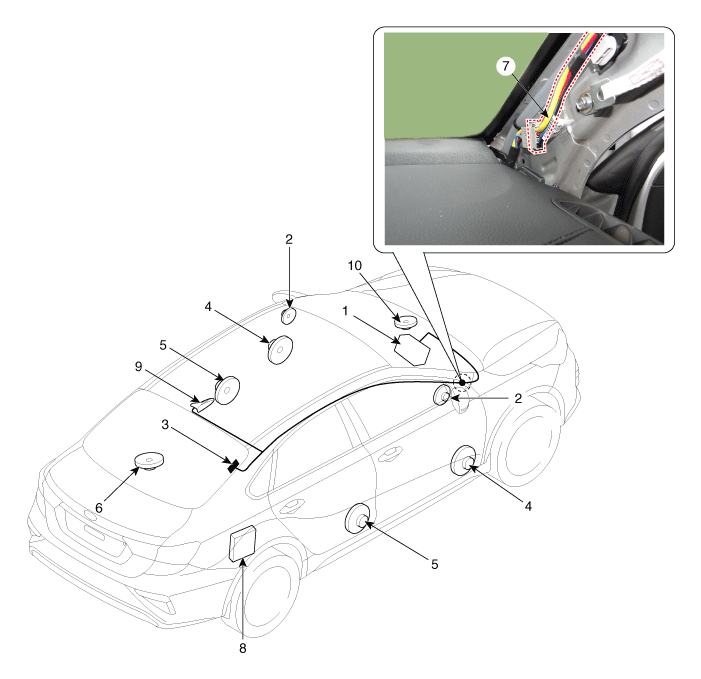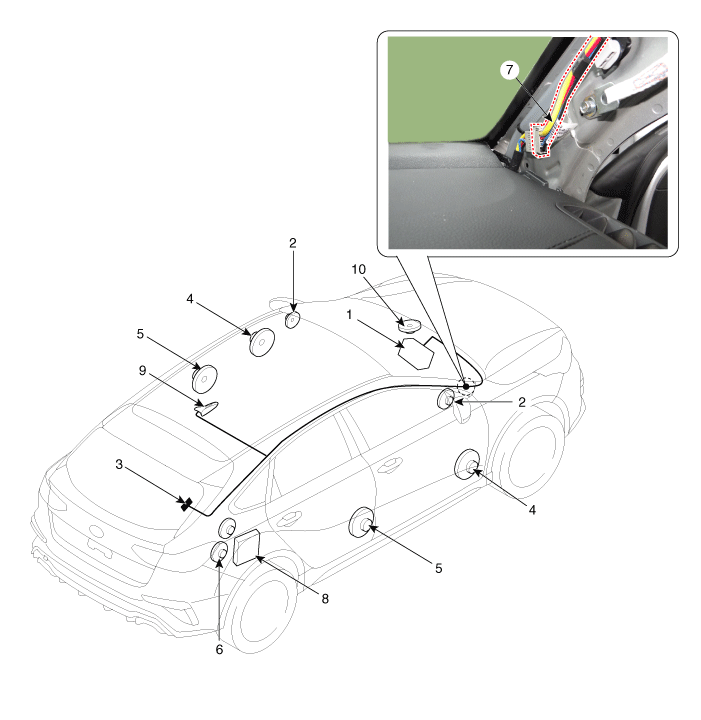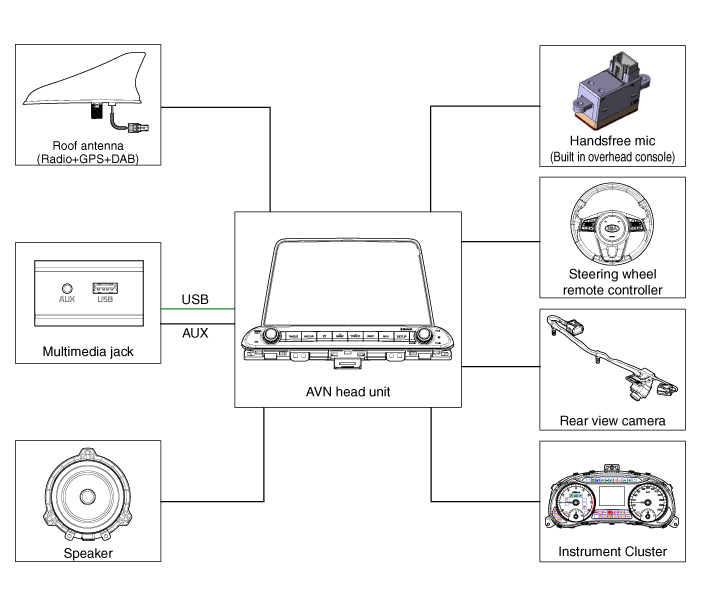Kia Forte: Body Electrical System / AVN System
Components and components location
| Component Location |
| [4DR] |

| 1. AVN head unit 2. Front tweeter speaker 3. Glass antenna amplifier 4. Front door speaker 5. Rear door speaker |
6. Subwoofer speaker (Option)
7. Antenna feeder cable 8. External amplifier (Option) 9. Roof antenna (Option) 10. Crash pad center speaker |
| [5DR] |

| 1. AVN head unit 2. Front tweeter speaker 3. Glass antenna amplifier 4. Front door speaker 5. Rear door speaker |
6. Subwoofer speaker (Option)
7. Antenna feeder cable 8. External amplifier (Option) 9. Roof antenna (Option) 10. Crash pad center speaker |
Description and operation
| Description |
AVN system
The AVN system simplifies system manipulation and by unifying the vehicle information and user information displays, improves information search and operation experience.
The system is basically composed of a keyboard for the operation of combined function, LCD monitor, a head unit with Bluetooth handsfree calling, voice recognition and navigation, music amplifier and the media unit that connects with other external devices.
System features
| 1. |
Simplification of user interface : the multimedia and car information are displayed on the monitor. |
| 2. |
Networked electronic parts : Efficient information transmission through CAN communications. |
| 3. |
Up-to-date technologies integrated :
|
System Block Diagram

Limitations of the Navigation System
GPS Signal Reception State
As the GPS satellite frequency is received/transmitted in straight lines, reception may not work if hiding devices are placed on or near the GPS antenna or when traveling through the following locations.
| • |
Tunnels |
| • |
Basement parking structures |
| • |
Underneath an overpass |
| • |
Roads within forested areas |
| • |
Areas near high rise buildings |
| • |
Roads within canyons |
Vehicle Position Display
| 1. |
If multipass errors occur due to reflections from buildings or related causes, the current position mark on the navigation may differ from the actual position of the vehicle. |
| 2. |
The position of the vehicle on the navigation may be different from the actual position if the vehicle is under the occur, driving for a short period of time will vehicle through map matching or GPS information (several minutes may be necessary in certain cases).
|
Route Guidance
Suitable route guidance may not occur caused by search conditions or the driving position.
| • |
Guidance to go straight may be given while driving on a straight road. |
| • |
Guidance may not be given even when having turned at an intersection. |
| • |
There are certain intersections in which guidance may not occur. |
| • |
A route guidance signaling entrance into a no enter zone may occur (No enter zone, road under construction, etc.) |
| • |
Guidance may be given to a position removed from the actual destination if roads to reach the actual destination do not exist or are too narrow. |
| • |
Faulty voice guidance may be given if the vehicle breaks from the designated route (ex : if a turn is made at an intersection while the navigation provided guidance to go straight). |
| • |
Map Data may be missing or incorrect causing route guidance to not be given. |
Route Re-calculation
The following phenomena may occur after conducting route recalculation.
| • |
When turning at an intersection, the navigation system gives wrong information on the current position. |
| • |
Route recalculation may take a longer period of time when driving under high speeds. |
| • |
A route guidance signaling for a U-Turn in a No U-Turn location may occur. |
| • |
A route guidance signaling entrance into a no enter zone may occur (No enter zone, road under construction, etc). |
| • |
Guidance may be given to a position removed from the actual destination do not exist or are too narrow. |
| • |
Faulty voice guidance may be given if the vehicle breaks from the designated route (ex : if a turn is made at an intersection while the navigation provided guidance to go straight) |
- AVN Head Unit
- Speaker
- External AMP
- AVN Antenna
- Steering Wheel Remote Controller (SWRC)
- Multimedia Jack
- Mic
 Auto Light Sensor
Auto Light Sensor
Repair procedures
Inspection
Check if the auto light control operates like a timing chart shown below. Tail
lamp output and head lamp (Low) output is controlled based on the auto light ...
 AVN Head Unit
AVN Head Unit
Components and components location
Components
1. Cluster fascia panel
2. Crash pad center garnish
3. Center air vent duct assembly
4. AVN upper panel
...
Other information:
Kia Forte 2019-2025 (BD) Service Manual: BJ Boot
Components and components location Components [RH] 1. BJ assembly 2. Clip 3. BJ boot band 4. BJ boot 5. Dynamic damper band 6. Dynamic damper 7. Shaft 8. TJ boot band 9. TJ boot 10. Spider assembly 11. Circ ...
Kia Forte 2019-2025 (BD) Service Manual: Side Sill Molding
Repair procedures Replacement Put on gloves to prevent hand injuries. When removing with a flat - tip screwdriver or remover, wrap prot ...
